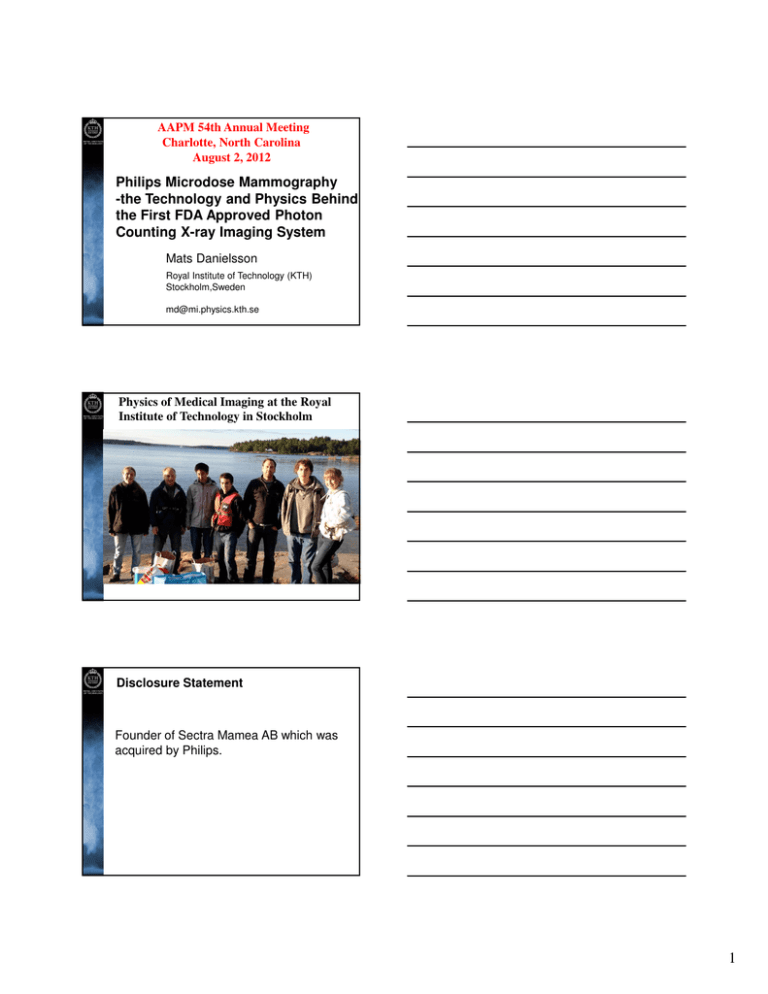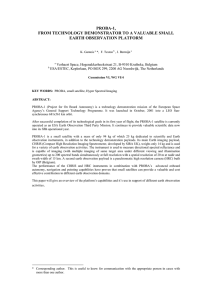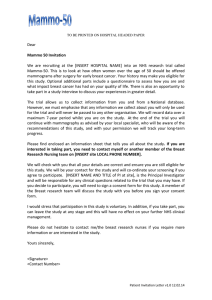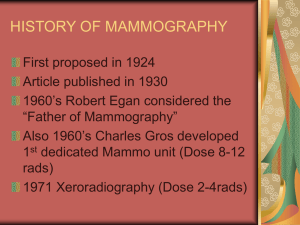Philips Microdose Mammography -the Technology and Physics Behind Counting X-ray Imaging System
advertisement

AAPM 54th Annual Meeting Charlotte, North Carolina August 2, 2012 Philips Microdose Mammography -the Technology and Physics Behind the First FDA Approved Photon Counting X-ray Imaging System Mats Danielsson Royal Institute of Technology (KTH) Stockholm,Sweden md@mi.physics.kth.se Physics of Medical Imaging at the Royal Institute of Technology in Stockholm Disclosure Statement Founder of Sectra Mamea AB which was acquired by Philips. 1 Challenges in Mammography Today •10-40% of cancers missed •Recall rate 1%-20% •Cost •Radiation Dose •Dense breasts ! What may help us? -Get rid of superimposed tissue -Visualize blood vessels associated to the cancer with contrast agent -Visualize the cancer with dual energy (spectral imaging) -More efficient sensors Fundamental Problem: Fundamental problem: ”Convert an x-ray photon into electric charge which you measure” 2 Who counted photons first? What was that? Maybe a photon To Count Photons – No Electronic Noise Energy X-ray photon Threshold 1 Threshold 2 Threshold 3 Noise 1 2 3 Time Integrating Current: Today’s praxis in X-ray Imaging Energy X-ray photons 1 Time 3 • Comparison of FFDM Technologies aSi flat panel aSe flat panel Photon Counting X-ray Photon X-ray Photon X-ray Photon Scintillator amplification Light Analog Capacitor charge storage Analog signal A/D - Converter Digital signal aSe X-ray into electrons MicroDose Detector Electrons Analog Capacitor charge storage Analog signal A/D - Converter Digital signal 5 (00000000000101) Digital signal 1 What is difficult with photon counting? Measured Effect of Dead Time R.L. Lucke Rev. Sci. Instrum. 47 (6):766 (1976) E. Fredenberg et al. SPIE 7258 (2009) 4 Measured Effect of Dead Time Deadtime per event 189 ns Deadtime at 20 kHz 0.4% Deadtime at 200 kHz 3.7% E. Fredenberg et al. SPIE Physics of Medical Imaging 2009 Philips – Photon Counting Mammography Today Crystalline Silicon Detector 5 Crystalline Silicon for Photon Counting Spatial resolution Spatial Resolution in Mammography 50 µm MicroDose Image 100 µm Image 1 Calcifications Case CC Close ups (from study by Cole et al.) FFDM Microdose 6 “Diagnostic Scan” is Microdose alternative to Geometric Magnification Use high DQE and deploy higher dose on the spot compression area. No magnification table. • Phantom evaluation shows Diagnostic Scan achieves better image results at a lower dose compared to Geometric Magnification. • “Performs comparably or better than conventional geometric magnification for the detection of masses and micro-calcifications, with the exception of mass lesions in larger breast, where GE conventional geometric magnification yields superior results” according to Egan et al, IWDM Philadelphia, PA (2012) Photon Counting CONFIDENTIAL Virtually Eliminates all Scatter Radiation Conventional Scatter Photon Counting No Scatter 7 Scattered radiation DQE at Zero Spatial Frequency DQE(0) PHILIPS MicroDose Photon Counting Monnin et al. Med. Phys., vol. 34 (3), pp. 906-914, 2007 System DQE Åslund, M. et al., 2010. Detectors for the future of x-ray imaging. Radiation Protection Dosimetry, 139(1-3), pp. 327-333 8 Does the clinical performance match the physics? Example 1: Experience from BreastCheck, The Irish Breast Screening Program • 4 static & 16 mobile screening units • Equipment: – 11 CsI scintillator – 10 a-Se – 7 Photon counting Ireland Breast Screening Program Cancer Detection Rates Mccullagh et al. The British Institute of Radiology (2011), The British Institute of Radiology, doi: 10.1259/bjr/29747759 doi: 10.1259/bjr/29747759 9 Ireland Breast Screening Program Cancer Detection Rates Mccullagh et al. The British Institute of Radiology (2011), The British Institute of Radiology, doi: 10.1259/bjr/29747759 doi: 10.1259/bjr/29747759 Ireland Breast Screening Program Radiation Dose Average Mean Glandular Dose 1.6 1.4 1.2 Philips MicroDose* mGy 1 GE Essential 0.8 0.6 Hologic Selenia 0.4 0.2 0 P Baldelli et. al., “Comprehensive Dose Survey Of Breast Screening In Ireland”, Radiation Protection Dosimetry , Vol. 145, No. 1, pp. 52–60, 2010 Example 2: E Cole, A Toledano, M Lundqvist, E Pisano "Comparison of Radiologist Performance with Photon-Counting Full-Field Digital Mammography to Conventional Full-Field Digital Mammography” Academic Radiology, Vol 19,(8) p 916-922, August 2012 10 Microdose versus standard FFDM • • Multi-slit Scanning Full-Field Digital Mammography System with Photon Counting Detector (Philips Mammography L30) Comparison Study between Philips L30 and GE FFDM conducted in 2010 – Multi-Case, Multi-Reader Study – Feature Analysis Study – Assessment of Dose Differences based on Breast Density, Breast Thickness Microdose versus standard FFDM • • 16 MQSA qualified Radiologist Readers 133 women (≥ age 40) from two European Sites: one in United Kingdom and one in Switzerland – 67 women were in the Normal Cohort (underwent Philips Microdose Mammography as part of their routine screening exam after having had a GE FFDM screening mammogram 10-30 months prior) [67 normal]. – 66 women were in the Diagnostic Cohort (had a screening Philips MDM mammogram and underwent diagnostic imaging with GE FFDM) [17 biopsy benign, 49 cancer] • Review Workstations at ACR Image Metrix Facility in Philadelphia, PA Microdose versus standard FFDM • • Each reader reviewed all 133 cases at two separate visits at least one month apart. Modalities were counterbalanced. Readers evaluated the images for presence of suspicious findings providing a BIRADS score(1-5) and a Probability of Malignancy score 0-100 11 Microdose versus Standard FFDM Philips L30 GE FFDM Difference pvalue AUC 0.947 (0.920, 0.974) 0.931 (0.898, 0.964) 0.016 (-0.001, 0.034) <0.001 Sensitivity 0.936 (0.897, 0.976) 0.908 (0.856, 0.960) 0.028 (-0.003, 0.059) <0.001 Specificity 0.764 (0.688, 0.841) 0.749 (0.668, 0.830) 0.015 (-0.022, 0.052) <0.001 Feature analysis resulted in Microdose being preferred to standard FFDM by the readers for >70% of the cases The average mean glandular dose for Microdose was 0.74 mGy FFDM average mean glandular dose was 1.23 mGy Further clinical trials Evidence from clinical trials: B. Hedson et al, "Digital vs. Screen-Film Mammography: A retrospective Comparison in a Population-Based ScreeningProgram”, European Journal of Radiology, Volume 64, Issue 3, p 419-425 S Weigel , R Girnus , J Czwoydzinski , T Decker , S Spital , W Heindel “Digital mammography screening: average glandular dose and first performance parameters.Rofo. 2007 Sep ;179 (9): p 892-895 M.G. Wallis, “Evaluation and Clinical assessment of Digital Mammography Screening using a Sectra Microdose full field Digital X-ray unit”, NHSBSP Equipment Report 0601, NHS Cancer Screening Programmes 2006 E Silicon is Proven Material Transport & storage not a problem temperatures from -10 C to 50 C 3 12 Also… -You need to be ready for the next photon, no “recovery time” for detector between exposure. -Curved surface and warm patient support = patient comfort 3 Philips MicroDose status summary -Low dose and high image quality 3 But what will happen in the future? 3 13 Challenges in Mammography Today •10-40% of cancers missed •Recall rate 1%-20% •Cost •Radiation Dose •Dense breasts ! What may help us? -Get rid of superimposed tissue -Visualize blood vessels associated to the cancer with contrast agent -Visualize the cancer with dual energy (spectral imaging) -More efficient sensors HighReX - a European Union Project 42 14 HighReX Objectives •Develop novel imaging methods using – 3D – dual energy – contrast mammography •with improved detection and diagnosis of breast cancer compared to current technology Multi-center clinical trial Finalized 2010 Duration: 3.5 years HighReX project Coordinator, (M. Danielsson) system supplier • Sectra Mamea AB, Sweden (aquired by Philips Sep. 2011) Clinical Partners • Addenbrooke’s Hospital, Cambridge, UK (M. G. Wallis) • S:t Göran’s Hospital, Stockholm, Sweden (K. Leifland) • Charité Hospital, Berlin, Germany (F. Diekmann) • Münster University Hospital, Munster, Germany (W. Heindel) • Health Unit of Pistoia, Florence, Italy (M. Rosselli del Turco) • Arcades, Marseille, France (B. Seradour) Other partners • Royal Surrey County Hospital NHS Trust • Stichting Landelijk Referentie Centrum voor Bevolkingsonderzoek • Radboud University Nijmegen Medical Centre Photon Counting Tomosynthesis 4 15 Geometry Geometry Projections Reconstructed volume Photon Counting Tomosynthesis • Scanning multi-slit system – Virtually no scatter radiation – Short exposure time (~1 s) • Photon counting detector – – – – Intrinsically fast image read-out Lower x-ray dose without compromising image quality No electronic noise (especially important in tomo) High resolution 50 micron pixel 16 Technical Data • X-ray tube and detector move in a synchronized motion • Tomosynthesis angle: 11 degrees • Scan angle of x-ray tube: +/- 17 degrees • Exposure time for a point << total scan time (~1 second exposure time) • Projections: 21 – one per detector line • Dose level from current clinical trial, prototype: 0.8 mGy for average breast, HighReX Cases 2D Tomo 17 Spiculated mass 2D Tomo Cyst 2D Tomo Spiculated mass 2D Tomo 18 Tomosynthesis Clinical Results • • • • • Photon counting tomo vs FFDM 10+10 readers, 130 cases (40 cancers, 24 benign, 66 normals) Results published in Radiology 2012 (1): Two-view tomosynthesis outperforms FFDM for less experienced radiologists (< 10 yrs) when measured as AUC scores for diagnostic accuracy, and also when measured by lesion type for masses and calcifications separately. No significant differences for one-view tomosynthesis vs FFDM Photon counting tomo dose was only 0.7-0.82 mGy (1) Two-View and Single-View Tomosynthesis versus Full-Field Digital Mammography: High-Resolution X-Ray Imaging Observer Study Radiology March 2012 262:3 788-796; Published online January 24, 2012, doi:10.1148/radiol.11103514 From: Marian Strassner [mailto:mstrassner@rsna.org] Sent: 17 May 2012 22:38 To: Wallis, Matthew Subject: Your article in Top 10 Most Read Dear Dr Wallis, We are pleased to inform you that your article Matthew G. Wallis, Elin Moa, Federica Zanca, Karin Leifland, Mats Danielsson Two-View and Single-View Tomosynthesis versus Full-Field Digital Mammography: High-Resolution X-Ray Imaging Observer Study Radiology Mar 01, 2012 262: 788-796. has been listed as one of the ‘Top 10 Most Read Recent Articles’ in Radiology for the last 3 months (FebruaryApril 2012). Contrast Agent 5 19 HighReX • Clinical trials o 2010 o Charité University Hospital Berlin o Dr. Felix Diekmann o Iodine Enhancement • 35 mm invasive lobular carcinoma Difficult to detect in 2D Difficult to detect in tomosynthesis Energy subtraction – clear improvement in this case • • • Courtesy Dr. Felix Diekmann Spectral Imaging 5 Single-shot spectral mammography Energy Photons Threshold 1 Noise 1 2 3 Time 60 20 Single-shot spectral mammography Energy Low-energy Photon High-energy Photons Threshold 2 Threshold 1 Noise 1 1 2 Time 61 6 On the photo you can tell what is what… Acrylic Acrylic Aluminum Aluminum Acrylic CONFIDENTIAL 6 But on the X-ray image, can you tell what is what? CONFIDENTIAL 6 21 On photon counting spectral you can! Spectral image of Aluminium All acrylic removed Al Al Spectral image of acrylic Aluminum removed Single-shot spectral imaging Applications for single-shot spectral mammography in screening 1) Breast density measurements * Providing the radiologist with objective data to assess individual risks 2) Lesion evaluation* Information acquired with the regular mammogram - no extra views - no extra acquisition time - no extra radiation - no contrast injection Providing the radiologist with objective data to help assess suspicious lesions And much more to come… 66 6 22 Spectral imaging - breast density measurements Why? fatty dense Breast cancer risk Mammography sensitivity Spectral imaging - breast density measurements How does it work? Glandularity: 16% BIRADS code: 1 DICOM structured report DICOM header data 68 Spectral imaging - breast density measurements What are the benefits? • • Objective data to assess and classify breast density Enables personalized care - Choice of modality - Screening interval - Reader focus and efforts fatty dense 23 Spectral imaging - lesion evaluation Why? • Recalls for benign findings are a major problem in screening – Increased costs – The cost of diagnostic workup and assessment of a recall is approximately eight times the cost of the screening – Unnecessary stress and exam for women • Up to 20% of recalls are due to circular lesions which are easy to detect but difficult to characterize 70 Spectral imaging - lesion evaluation How does it work? Lesion content: Lesion diameter: Lesion thickness: Breast thickness: ROI glandularity: Water 13 mm 6 mm 39 mm 28% Spectral imaging - lesion evaluation What are the benefits? • For the radiologists – Objective data to evaluate lesions water content – Reduced costs generated by unnecessary recalls • For the woman - Possibility to avoid uneccessary exams and stress Low dose 24 Publications • SPIE 2009 – A photon-counting detector for dual-energy breast tomosynthesis, E. Fredenberg, M. Lundqvist, M. Aslund, M. Hemmendorff, B. Cederstrom, M. Danielsson The photon-counting detector enables dual-energy subtraction imaging with electronic spectrum splitting. This improved the detectability of iodine in phantom measurements, and the detector was found to be stable over typical clinical acquisition times. • SPIE 2010 – Observer model optimization of a spectral mammography system, E. Fredenberg, M. Lundqvist, M. Aslund, B. Cederstrom, M. Danielsson • SPIE 2011 Evaluation of photon-counting spectral breast tomosynthesis, N. Dahlmana, E. Fredenberga, M. Åslund, M. Lundqvist, F. Diekmann, M. Danielsson It was shown experimentally that unenhanced spectral imaging may increase detectability of tumors in the order of a factor two if anatomical noise dominates. The model comparison revealed that contrast-enhanced spectral imaging and tomosynthesis can be combined to improve tumor detectability. – Optimization of mammography with respect to anatomical noise, E. Fredenberg, B. Svensson, M. Danielsson, B. Lazzari, B. Cederstrom Publications • • SPIE 2012 – Lesion characterization using spectral mammography, E. Fredneberg PhD, K. Leifland MD, B. Norell PhD, B. Cederström PhD, M. Lundqvist PhD – Photon-Counting Spectral Phase-Contrast Mammography, E. Fredenberg, E. Roessl, T. Koehler, U. van Stevendaal, I. Schulze-Wenck, N. Wieberneit, M. Stampanoni, Z. Wang, R. A. Kubik-Huch, N. Hauser, M. Lundqvist, M. Danielsson, M. Åslund – Prof. Dr. Walter Heindel, Referenzzentrum Mammographie, Am Universitätsklinikum Münster, Münster, Germany Other – Contrast-enhanced spectral mammography with a photon-counting detector, E. Fredenberg, M. Aslund, M. Hemmendorff, B. Cederstrom, M. Danielsson, Med. Phys. (2010) Vol. 37, No. 5, May – Energy resolution of a photon-counting silicon strip detector, E. Fredenberg, M. Aslund, M. Lundqvist, B. Cederstrom, M. Danielsson, Nucl. Instr. and Meth. (2010) Vol. 613, No. 1, pp. 156-162 – Detectors for the future of X-ray imaging, E. Fredenberg, M. Aslund, M. Telman, M. Danielsson, Radiation Protection Dosimetry (2010), Vol. 139, No. 1–3, pp. 327–333 Does it help? • Contrast agent -Yes (but not in screening) • Spectral Imaging -Maybe • Tomosynthesis -No 25 Quality Control and Physics Measurements Philips Micodose QC philosophy • Based primarily on – IEC standards (e.g. IEC 61223-2-10, IEC 61223-32) – European guidelines for quality assurance in breast cancer screening and diagnosis, 4th Ed. (European Comission) – MQSA – Our own experience and knowledge about critical system parameters Overview of Some Medical Physicist QC Tests For detailed step-by-step procedures for all tests please see the QC manual or contact David Nelson David.Nelson@philips.com 26 Structure of QC procedures Frequency Performed by Daily Weekly Monthly QC technologist Quarterly Annual Medical physicist Medical Physicist QC procedures – Annual Annual 1 X-ray tube output 2 Air kerma reproducibility 3 Half value layer (HVL) 4 AEC: Breast thickness tracking 5 AEC: Density compensation 6 Image quality evaluation 7 CNR reference level 8 Tube voltage 9 Image field and x-ray field agreement 10 Missed tissue at chest wall 11 Viewing conditions 12 Guidance system control MicroDose Differences -Good to know for the physicist 27 Spatial resolution? Different blurring mechanisms in the two directions Spatial resolution, cont. • Slit-direction: – Similar to other systems: resolution best on patient support in the MicroDose • Scan-direction: – Opposite to other systems: resolution best farthest up in the MicroDose MTF at two heights On breast support 5 cm above MTF 6 cm from chest wall and on pat. supp. 1 Slit dir. Scan dir. Slit dir. Scan dir. 0.9 0.8 0.8 0.7 0.7 0.6 0.6 MTF [r.u.] MTF [r.u.] 0.9 0.5 0.5 0.4 0.4 0.3 0.3 0.2 0.2 0.1 0 MTF 6 cm from chest wall and 5 cm above pat. supp. 1 0.1 0 2 4 6 8 10 12 Spat. freq. [lp/mm] 14 16 18 20 0 0 2 4 6 8 10 12 Spat. freq. [lp/mm] 14 16 18 20 28 Spatial resolution, cont. • Slit-direction: MTF factors – Focal spot length – Pixel size • Scan-direction: MTF factors – Focal spot width – Collimator slit width Recommended test • Monthly QC test using line pair phantom placed on top of BR12 or acrylic plate (~45 mm) Both parallel and perpendicular to scan direction Only technologist needs to perform this test Pass criteria is visibility >= 6 lp/mm We would like the physicist to be aware of the test • • • • MicroDose – mAs By mAs we mean effective mAs • • • • • Conv. mAs = tube current × exposure time Eff. mAs = tube current × (eff. exposure time for one point in image) Eff. mAs = conv. mAs × open width in collimator / total scan length Eff. mAs ≈ conv. mAs × 1% If not explicitly stated otherwise we always mean eff. mAs Multi-slit collimator Scan direction Detector lines 29 MicroDose – mAs By mAs we mean effective mAs • • Conv. mAs = tube current × exp. time Eff. mAs = tube current ×(eff. exposure time for one point in image) = conv. mAs × open width in collimator / total scan length ≈ conv. mAs × 1% Pulse duration = 10- 50 msec Pulse freq = 5-30 per sec Required Tools for Medical Phycisist QC Medical Physicist Required Tools 30 Medical Physicist Required Tools (contd.) Tube Output Measurements Considerations • Radiation to detector is pulsed (ensure your dose meter can handle it) • W/Al anode/filter combination (meter calibrated for e.g. Mo/Mo can give very wrong results) • Scale dose using inverse square law to 45 mm above patient support. Source-to-patient support = 640 mm • Measured values should be within +/-20% of system calculated • Air Kerma reproducability Unfors jig for dose measurements must be within 5% rel. stdev HVL • • • • • Use ion chamber or other dose meter calibrated* for the radiation quality of the MicroDose system (W anode and 0.5mm Al filtration). Place compression paddle 9 cm above patient support to minimize scatter effects. Place a lead sheet with hole on paddle. Verify collimator is lined up with dose meter. Place Al filters on lead sheet as required. * Ion chambers work fine Solid state detectors - Unfors is calibrated - In discussions with RadCal and Keithly 31 Exposure and CNR Test • • • • • • • • • • Verifies AEC ensuring optimal exposure Acrylic is not equivalent to breast tissue Flat acrylic on curved surface introduces bias System corrects for thickness measurement Test uses acrylic plates 20-70 mm and 0.1/0.2 mm Al filter Use ROI tool to calculate CNR Use HVL and air kerma to calculate AGD - use breast thickness not acrylic thickness AGD = ESAK x g x c x s (QC manual) Measured AGD shall be within 15% of system value CNR should exceed CNR threshold (QC manual) ± ~13 mm gap Phantom Image Quality • • • • Acquire ACR phantom image (no disk) Score the phantom on AWS or RWS At least 4 fibers, 3 groups of micro-calcifications, and 3 masses must be seen (total score must be at least 10) Calculate dose and should not exceed 1 mGy CNR Reference Level • • • • • Establish operating level of CNR Phantom available from Philips Use Daily Quality Control (DQC) tool Measure CNR and establish reference value QC Tech to ensure daily CNR is within +/-10% of reference 32 SNR Test • To check if constant SNR is maintained regardless of breast transmission • Acrylic slabs 30-50 mm in 5 mm steps • Use ROI tool • SNR calculated for each slab thickness • Measured SNRs to be within +/- 15% of average SNR value Summary -Important to know some tricks of the trade for QC -No scattered radiation and photon counting result in high image quality at half the radiation dose -Future possibilities with spectral imaging Thank’s! 33





